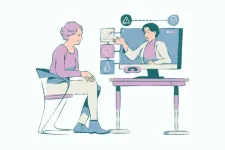(Press-News.org) DETROIT — Wayne State University researchers recently received a grant from the Great Lakes Protection Fund to team with the Huron River Watershed Council, the Cleveland Water Alliance, Buffalo Niagara Waterkeeper and Resource Recycling Systems to help communities combat microplastics in water sources.
The project, “Mobilizing a Great Lakes Microplastic Action Network,” is led by Yongli Wager, Ph.D., associate professor of civil and environmental engineering and director of the Sustainable Water-Environment-Energy Technologies Lab in Wayne State’s College of Engineering. The project’s goal is to create a Great Lakes-focused microplastic action network that will use proven reduction strategies and new analytic tools — including a new open-source analytic engine, or “library” — for identifying environmental microplastics. The library will empower communities with the ability to identify local pollution sources for the first time, offering new opportunities for microplastic pollution mitigation at a local level.
“We are going to work with a number of community leaders and each will have their own network of partners,” said Wager. “Together we will collect samples from the Great Lakes and local rivers and analyze them for plastics at both the macro and micro scale. With the resulting data, we will see things like the material type, color, texture, size and shape of the plastics. That way, we can tell where it comes from and where the sources are such as plastic bags, plastic packaging, plastic fibers in washing water and so forth.”
This four-year, $1,190,000 award from the Great Lakes Protection Fund will analyze environmental microplastics to infer the likely source, fate, and transport of microplastic samples. Pilot communities will be able to target source-specific strategies and learn from their actions. Using data generated from the new library, communities will take actions to reduce microplastics in their local context.
“We worked very closely with community partners to build educational materials on microplastics,” said Wager. “We want them to reach out to residents, organizations and businesses so they understand the impact plastic waste can have on the environment and human health. We hope this will promote positive change to reduce plastic in the environment. With the resulting data, we can better create specific materials for local communities. They will be able to see what type of microplastics are affecting their specific community and then determine how to best address that.”
Potential responses by communities could include implementing improved practices in wastewater filtration to address point sources, targeting single-use plastics through public awareness campaigns, supporting restaurant associations in identifying alternatives to plastic containers, implementing new washing machine filters to reduce microfibers in washing water, and targeting manufacturers releasing harmful materials in the water supply chain.
“This important research effort will provide critical resources and engage with communities to improve water quality,” said Ezemenari M. Obasi, Ph.D., vice president for research & innovation at Wayne State University. “I look forward to the impact of this important work by Dr. Wager’s team on the Great Lakes and beyond.”
# # #
About Wayne State University
Wayne State University is one of the nation’s pre-eminent public research universities in an urban setting. Through its multidisciplinary approach to research and education, and its ongoing collaboration with government, industry and other institutions, the university seeks to enhance economic growth and improve the quality of life in the city of Detroit, state of Michigan and throughout the world. For more information about research at Wayne State University, visit research.wayne.edu.
Wayne State University’s research efforts are dedicated to a prosperity agenda that betters the lives of our students, supports our faculty in pushing the boundaries of knowledge and innovation further, and strengthens the bonds that interconnect Wayne State and our community. To learn more about Wayne State University’s prosperity agenda, visit president.wayne.edu/prosperity-agenda.
END
Doctors and researchers at the University of Colorado Anschutz Medical Campus published a discussion paper today highlighting key initiatives to help strengthen, train and prepare doctors and health care workers for the impact of climate change on human health.
The paper is published in the National Academy of Medicine Perspectives.
The authors, who come from a diverse background in health care from pediatrics to emergency medicine, and nursing to pharmacy, outline the importance of educating a climate-savvy health care workforce and highlight educational opportunities to fulfill the critical need.
“As climate change increasingly ...
BINGHAMTON, N.Y. -- Telemedicine actually improves the quality of care and increases physician satisfaction in delivering that care, according to new research from Binghamton University, State University of New York.
We all remember when the COVID-19 lockdown in early 2020 upended the comfort of our daily routines. Businesses were forced to adapt to limited ways of engaging with customers, with varied levels of success.
Lockdown posed a unique challenge for physicians: they couldn’t meet with every patient in person. Telemedicine became not only an alternative but the best option for seeing patients in remote areas or where infection rates ...
Quasars are the most luminous objects in the Universe and are powered by material accreting onto supermassive black holes at the centers of galaxies. Studies have shown that early-Universe quasars have black holes so massive that they must have been swallowing gas at very high rates, leading most astronomers to believe that these quasars formed in some of the densest environments in the Universe where gas was most available. However, observational measurements seeking to confirm this conclusion have thus far yielded conflicting results. Now, a new study using the Dark Energy Camera ...
Fatah Kashanchi, Professor, Virology, School of Systems Biology, College of Science; Director, Laboratory of Molecular Virology, received funding for the study: “Parasite-Derived Vesicles in Babesia virulence and Vaccine Development.”
Babesia is a parasite spread by ticks. If humans contract babesiosis, they can experience influenza-like symptoms, bleeding, and organ failure. The condition is rare and affects fewer than 3,000 people in the United States per year.
Kashanchi will isolate extracellular vesicles (EVs) and utilize them to treat primary monocyte-derived macrophages ...
NEW YORK, NY (Sept. 23, 2024)--Children born during the first year of the pandemic, including those exposed to COVID in utero, were no more likely to screen positive for autism than unexposed or pre-pandemic children, found researchers from Columbia University Vagelos College of Physicians and Surgeons.
The study, published in JAMA Network Open, is the first report on autism risk among pandemic-era children.
“Autism risk is known to increase with virtually any kind of insult to mom during pregnancy, including infection and stress,” says Dani Dumitriu, ...
About The Study: The results of this cohort study suggest that maternal influenza infection during pregnancy was associated with an increased risk of childhood seizures, especially febrile seizures, but not epilepsy. Further studies are needed to elucidate the mechanisms underlying childhood neurological development.
Corresponding Author: To contact the corresponding author, Ming-Chih Lin, MD, PhD, email mingclin@gmail.com.
To access the embargoed study: Visit our For The Media website at this link https://media.jamanetwork.com/
(doi:10.1001/jamanetworkopen.2024.34935)
Editor’s ...
About The Study: In this cohort study of 2 groups of children with prenatal pandemic exposure and/or exposure to maternal SARS-CoV-2 infection, neither exposure was associated with greater Modified Checklist for Autism in Toddlers, Revised positivity.
Corresponding Author: To contact the corresponding author, Dani Dumitriu, MD, PhD, email dani.dumitriu@columbia.edu.
To access the embargoed study: Visit our For The Media website at this link https://media.jamanetwork.com/
(doi:10.1001/jamanetworkopen.2024.35005)
Editor’s Note: Please ...
About The Study: The findings from this cross-sectional study demonstrate that the legacies of redlining, intertwined with current dynamics of displacement and gentrification, affect severe maternal morbidity. Place-based sociopolitical mechanisms that inequitably distribute resources may be important intervention points to address structural drivers of adverse pregnancy outcomes and their racial inequities.
Corresponding Author: To contact the corresponding author, Mahasin S. Mujahid, PhD, ...
About The Study: The findings of this study suggest a benefit of gamified digital mental health interventions for youth with attention-deficit/hyperactivity disorder (ADHD) or depressive disorder. Pediatricians and other health care professionals have new information about novel, accessible, and efficacious options for pediatric mental health care.
Corresponding Author: To contact the corresponding author, Joseph F. McGuire, PhD, email jfmcguire@jhmi.edu.
To access the embargoed study: Visit our For The Media website ...
About The Study: This study found that approximately one-third of living former professional football players reported perceived chronic traumatic encephalopathy (CTE). Men with perceived CTE had an increased prevalence of suicidality and were more likely to have health problems associated with cognitive impairment compared with men without perceived CTE. Perceived CTE represents a novel risk factor for suicidality and, if present, should motivate the diagnostic assessment and treatment of medical and ...


